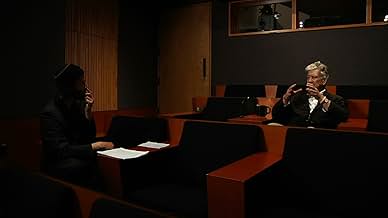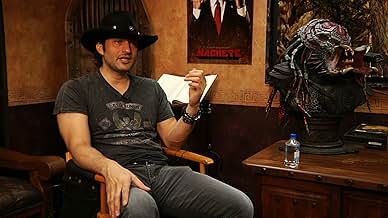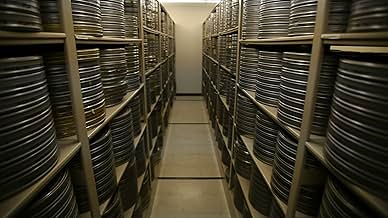NOTE IMDb
7,6/10
14 k
MA NOTE
Ajouter une intrigue dans votre langueThe documentary investigates the history, process and workflow of both digital and photochemical film creation.The documentary investigates the history, process and workflow of both digital and photochemical film creation.The documentary investigates the history, process and workflow of both digital and photochemical film creation.
- Réalisation
- Scénario
- Casting principal
- Récompenses
- 1 nomination au total
Avis à la une
"People love great stories. They love to get into a world and have an experience. And how they get it—it doesn't really matter." David Lynch
Which do you prefer: photochemical or digital projection for your movies? If you're geeky enough, you really care; if not, like me, you want a great story and characters with a crisp image that complements the theme, regardless of whether or not it's film. As for 3D, I can live without it.
Christopher Kenneally's interesting Side by Side documentary presents filmmakers like George Lucas who claim celluloid is dead and those like Christophe Nolan who vow not yet to trade his "oil paints for crayons." The film does a credible job presenting both sides with a slight edge to a future of all digital and a pessimistic take on film as an eventual curiosity.
Among the talking heads are avatars of photography and direction with an occasional producer and actress to get closer to us viewers, who are never questioned even though we are the ultimate arbiters. But the experts have valid and provocative points: the film advocates tout its warmth and color possibilities while the digital dudes trumpet the ease, low cost, and creative infinity. The film does an entertaining job of presenting the sides.
Both sides agree archiving remains a pressing and often neglected issue. Although Martin Scorsese is at the forefront of saving film, no one else has yet taken the case of digital preservation with his passion. The documentary doesn't take enough time on this issue especially since I thought something like my external hard drive would already be in the mix. Not. Apparently even digital imaging can break down in storage.
Oh, well, I'm with Lynch: Give me a super story and beautiful image and let the geeks and gods work out the details.
Which do you prefer: photochemical or digital projection for your movies? If you're geeky enough, you really care; if not, like me, you want a great story and characters with a crisp image that complements the theme, regardless of whether or not it's film. As for 3D, I can live without it.
Christopher Kenneally's interesting Side by Side documentary presents filmmakers like George Lucas who claim celluloid is dead and those like Christophe Nolan who vow not yet to trade his "oil paints for crayons." The film does a credible job presenting both sides with a slight edge to a future of all digital and a pessimistic take on film as an eventual curiosity.
Among the talking heads are avatars of photography and direction with an occasional producer and actress to get closer to us viewers, who are never questioned even though we are the ultimate arbiters. But the experts have valid and provocative points: the film advocates tout its warmth and color possibilities while the digital dudes trumpet the ease, low cost, and creative infinity. The film does an entertaining job of presenting the sides.
Both sides agree archiving remains a pressing and often neglected issue. Although Martin Scorsese is at the forefront of saving film, no one else has yet taken the case of digital preservation with his passion. The documentary doesn't take enough time on this issue especially since I thought something like my external hard drive would already be in the mix. Not. Apparently even digital imaging can break down in storage.
Oh, well, I'm with Lynch: Give me a super story and beautiful image and let the geeks and gods work out the details.
One of the most important things about a documentary is subject matter. If you do not have an interesting topic then you will not only get the viewers but you won't be able to keep them. The latest documentary film Side By Side does something a little bit different than most of this genre. It tackles a subject that those outside the industry may know nothing about but are affected by it nonetheless.
Side By Side takes a tour through the history of filmmaking through the impact that the rise of digital filmmaking has had. Featuring an impressive list of filmmakers including George Lucas, Martin Scorsese, James Cameron, Robert Rodriguez, David Lynch, David Fincher, Steven Soderbergh, Christopher Nolan as well as numerous industry professionals this film explores both the good and bad of this rise of the digital age through the creative eyes of those that make these films. For anyone that loves film this is a must see documentary. Not only do you see how it affected tons of different movies, but also how it changed the industry. With Keanu Reeves leading the charge interviewing the power house of Hollywood it delivers a different side of the world of imagination that we all love. In addition to getting a peek behind the curtain that audiences normally never think twice about, we are also given a look at who really had their hand in this evolutionary change and what films took these leaps. This is an effective film that works on many levels more than just a documentary on cameras. It tells the story of film processing, camera evolution, filmmaking, and a true chance for those that work behind the scenes to give their opinions and thoughts on this evolution, the good and bad.
There are some very emotional responses here that really show the love these filmmakers have for what they do and will offer a great inside look and should give you a new respect for the process and creators as well as the films themselves. Some feel this is the end of true film while others feel this is the birth of unlimited creativity, either way this film evokes an emotional response both on the screen and from the viewer which is what film is all about.
http://www.examiner.com/movie-in-dallas/bobby-blakey
Side By Side takes a tour through the history of filmmaking through the impact that the rise of digital filmmaking has had. Featuring an impressive list of filmmakers including George Lucas, Martin Scorsese, James Cameron, Robert Rodriguez, David Lynch, David Fincher, Steven Soderbergh, Christopher Nolan as well as numerous industry professionals this film explores both the good and bad of this rise of the digital age through the creative eyes of those that make these films. For anyone that loves film this is a must see documentary. Not only do you see how it affected tons of different movies, but also how it changed the industry. With Keanu Reeves leading the charge interviewing the power house of Hollywood it delivers a different side of the world of imagination that we all love. In addition to getting a peek behind the curtain that audiences normally never think twice about, we are also given a look at who really had their hand in this evolutionary change and what films took these leaps. This is an effective film that works on many levels more than just a documentary on cameras. It tells the story of film processing, camera evolution, filmmaking, and a true chance for those that work behind the scenes to give their opinions and thoughts on this evolution, the good and bad.
There are some very emotional responses here that really show the love these filmmakers have for what they do and will offer a great inside look and should give you a new respect for the process and creators as well as the films themselves. Some feel this is the end of true film while others feel this is the birth of unlimited creativity, either way this film evokes an emotional response both on the screen and from the viewer which is what film is all about.
http://www.examiner.com/movie-in-dallas/bobby-blakey
I tend to read proper film critics for their opinions not only on specific films but also essays on themes, genres, movements and so on; I consider myself a total amateur on such subjects but I find it interested to listen to those who are not. Coming to Side by Side I wasn't sure if it would be too dry for me to get into or if it would be too simplistic for me to stay interested in for just under two hours. The film essentially looks at the transition from celluloid to digital in film making – from filming through to post through to projection in the cinema and the means of delivery to the viewer. It is an ambitious goal but it is one that it does very well and in a way that flows and is accessible.
I guess that for those with a real good working knowledge of the technology and the process, it may be too simplistic but for the casual viewer and enjoyer of films, there is enough detail here to engage and interest, but not so much that I felt overwhelmed with technical detail that I wasn't interested in. The film is really made up of Reeves acting as interviewer with a range of people involved in all the various aspects of the process – directors, cinematographers, editors, camera manufacturers etc. and he does a decent job, but not a great job in this regard. Fortunately this is not really his main role because it certainly seems that as producer he has helped Kenneally get a lot of very famous people to agree to be in the film. This range of talent and opinion makes for an interesting film, so while we follow development of things over time, we tend to get both sides as the title suggests.
Most of the contributors are interesting and their soundbites are well edited and the film itself is put together very well so that it covers time and technology in a way that makes sense, engages and never outstays its welcome. It probably won't do much for the technical enthusiast but for fans of film and cinema it is very much worth seeing as entertainment and education.
I guess that for those with a real good working knowledge of the technology and the process, it may be too simplistic but for the casual viewer and enjoyer of films, there is enough detail here to engage and interest, but not so much that I felt overwhelmed with technical detail that I wasn't interested in. The film is really made up of Reeves acting as interviewer with a range of people involved in all the various aspects of the process – directors, cinematographers, editors, camera manufacturers etc. and he does a decent job, but not a great job in this regard. Fortunately this is not really his main role because it certainly seems that as producer he has helped Kenneally get a lot of very famous people to agree to be in the film. This range of talent and opinion makes for an interesting film, so while we follow development of things over time, we tend to get both sides as the title suggests.
Most of the contributors are interesting and their soundbites are well edited and the film itself is put together very well so that it covers time and technology in a way that makes sense, engages and never outstays its welcome. It probably won't do much for the technical enthusiast but for fans of film and cinema it is very much worth seeing as entertainment and education.
This is a fantastic documentary which provides a window into the technical elements of the way an image is captured by cameras for motion pictures. Most of us are aware that there are two mediums- film, - which has been the method of application up until the last decade or two, and digital- which is trying to supplant film. It is an interesting look at the junction of art and science to create a feature film and the kind of hurdles these mediums, and the people using them have to overcome. Keanu Reeves is an excellent host and the usually drab actor seems full of energy here, asking furtive questions and giving feedback and opinion. There are a host of subjects interviewed here, from legendary filmmakers and cinematographers to producers and movie moguls. I prefer the look of film stock and will side with it, but there is no denying the strides digital cameras have made in recent years. And perhaps the greatest takeaway from this documentary is that it doesn't really matter what medium you shoot on- it is the person behind the camera that matters.
This is a documentary that every film enthusiast must watch. It will give you an understanding of the ways a feature film is shot and projected. To the unaware today most movies are shot on digital cameras as opposed to the photochemically styled film cameras of the past days. Both have their plus and minuses and in this documentary, Keanu Reeves goes about explaining the differences of the format and the opinion of most famous filmmakers on the subject. Featuring everyone from James Cameron to Martin Scorsese Side by Side is a great look at the technical aspect of cinema.
Histoire
Le saviez-vous
- GaffesIdentifies District 9 (2009) as being shot on the Sony F23. It was actually shot on Red One cameras.
- Citations
Martin Scorsese: The only way you can make sure that a film or anything on the moving image is going to be around sixty or seventy years from now, interestingly enough, ironically enough, is celluloid.
- ConnexionsFeatured in Film '72: Épisode datant du 13 février 2013 (2013)
Meilleurs choix
Connectez-vous pour évaluer et suivre la liste de favoris afin de recevoir des recommandations personnalisées
- How long is Side by Side?Alimenté par Alexa
Détails
Box-office
- Montant brut aux États-Unis et au Canada
- 58 825 $US
- Week-end de sortie aux États-Unis et au Canada
- 6 956 $US
- 19 août 2012
- Montant brut mondial
- 67 054 $US
- Durée1 heure 39 minutes
- Couleur
- Rapport de forme
- 1.85 : 1
Contribuer à cette page
Suggérer une modification ou ajouter du contenu manquant

Lacune principale
By what name was Side by Side (2012) officially released in Canada in English?
Répondre




































